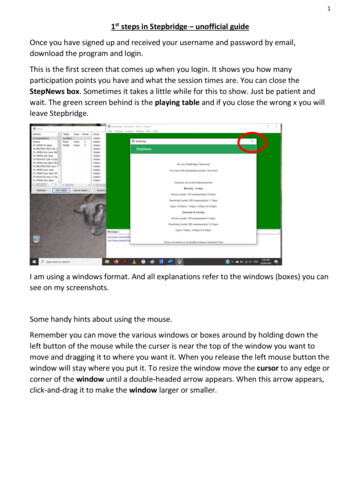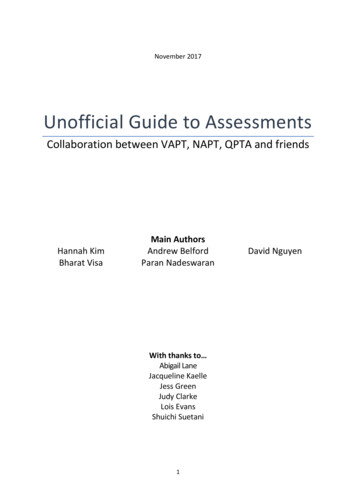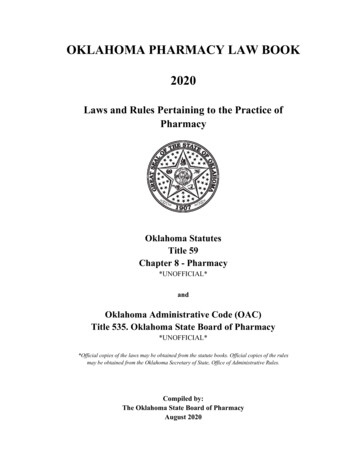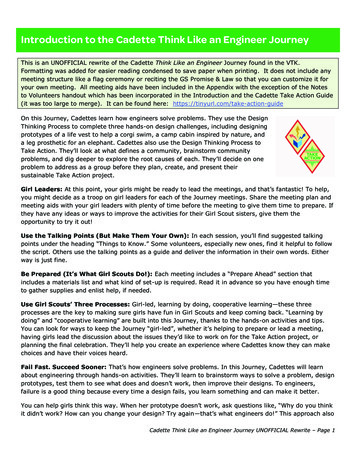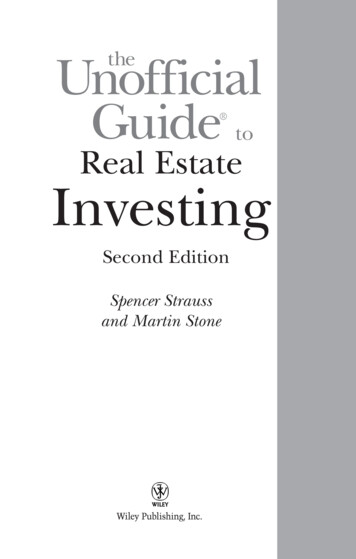
Transcription
theUnofficialGuide toReal EstateInvestingSecond EditionSpencer Straussand Martin Stone
theUnofficialGuide toReal EstateInvestingSecond EditionSpencer Straussand Martin Stone
Copyright 2003 by Wiley Publishing, Inc. All rights reserved.Published by Wiley Publishing, Inc., Hoboken, NJNo part of this publication may be reproduced, stored in a retrieval system or transmitted in any form or by any means, electronic, mechanical, photocopying, recording,scanning or otherwise, except as permitted under Sections 107 or 108 of the 1976United States Copyright Act, without either the prior written permission of thePublisher, or authorization through payment of the appropriate per-copy fee to theCopyright Clearance Center, 222 Rosewood Drive, Danvers, MA 01923, (978) 750-8400,fax (978) 646-8700. Requests to the Publisher for permission should be addressed tothe Legal Department, Wiley Publishing, Inc., 10475 Crosspoint Blvd., Indianapolis, IN46256, (317) 572-3447, fax (317) 572-4447, E-mail: permcoordinator@wiley.com.Trademarks: Wiley and the Wiley Publishing logo are trademarks or registered trademarks of Wiley Publishing, Inc., in the United States and other countries, and maynot be used without written permission. All other trademarks are the property of theirrespective owners. Wiley Publishing, Inc., is not associated with any product or vendor mentioned in this book.Limit of Liability/Disclaimer of Warranty: While the publisher and author have usedtheir best efforts in preparing this book, they make no representations or warrantieswith respect to the accuracy or completeness of the contents of this book and specifically disclaim any implied warranties of merchantability or fitness for a particularpurpose. No warranty may be created or extended by sales representatives or writtensales materials. The advice and strategies contained herein may not be suitable foryour situation. You should consult with a professional where appropriate. Neitherthe publisher nor author shall be liable for any loss of profit or any other commercialdamages, including but not limited to special, incidental, consequential, or otherdamages.For general information on our other products and services or to obtain technical support please contact our Customer Care Department within the U.S. at 800-762-2974,outside the U.S. at 317-572-3993 or fax 317-572-4002.Wiley also publishes its books in a variety of electronic formats. Some content thatappears in print may not be available in electronic books.Cataloguing in Publication information available from the Library of Congress.ISBN: 0-7645-3709-1Manufactured in the United States of America10 9 8 7 6 5 4 3 2 1Second EditionBook design by Lissa Auciello-BroganCover design by Wendy MountPage creation by Wiley Publishing, Inc. Composition Services
Spencer Strauss dedicates this book to Marty Stone for hisfriendship and never-ending support and to his late fatherMarty Strauss: “Dad, today I am a fountain pen.”Martin Stone dedicates this book to his wife Lori for her loveand encouragement and to his longtime teacher, mentor,and friend Jack Buckingham.
AcknowledgmentsWe would like to thank all the fantastic people at WileyPublishing, Inc., who made this book possible: mostnotably Kathy Nebenhaus, Keith Covington, SuzanneSnyder, and the remarkable Roxane Cerda. Thank you all foryour commitment to this book and making our job easy.We also would like to acknowledge the staff at Hungry Mindswho worked so hard on the first edition, including, Matthew X.Kiernan, Randy Ladenheim-Gil, Jessica Faust, Jennifer Perillo,Brice Gosnell, Faunette Johnston, Georgette Blau, WilliamBronchick, Warren Ladenheim, Ed Stevens, and Amy Lepore.Finally, we owe a debt of gratitude to the following people,without whom we wouldn’t have been able to write this book:Steven D. Strauss, Lori Stone, Sheree Bykofsky, Blake Mitchell,Chris Stone, Sandi Strauss, Larry Strauss, Maria Strauss,Jillian Lewis, Kirk and Leslie Melton, Aaron Cook, Adam Cook,Hans Harder, Ben Walton, Jay Treat, Shelly Stone, JamesWaedekin, Ned Mansour, Jim Frings, Marianne Choy, MichaelB. Moynahan, Kerry and Mia Daveline, Glenn Bozarth andSeymour Fagan. Thanks to all of you for your support.
I Understanding Real EstateAs an Investment.11 Planting the Seed .3A new world order .4Investing versus speculating .7Taking a chance .10The roots of lending .11Great government subsidies .13Leveraged compound interest .16Just the facts .192 The Process and the Plan .21Short-term profits .22Middle-years payoffs .24The retirement years .30A systematic approach to investing .31Just the facts .40II The Secrets of Real Estate Investing .413 Elements of Return .43333 Richmond Street .44Cash flow .45Equity growth from loan reduction .49Equity growth from appreciation .50Tax shelter benefits .56vContentsAbout the Authors .xiIntroduction .xiii
viCONTENTSModified Accelerated Cost Recovery System.58Calculating the return .60Just the facts .634 Appraising Like an Appraiser .65Methods of valuing property .66A summary of value .81The gross rent multiplier .82Finding hidden value .85Highest and best use .87Just the facts .885 Borrowing Big Bucks .91Show me the money .92Locating a lender .94The conventional route .98Fixed-rate mortgages .103Adjustable-rate mortgages (ARMs) .104Assumable loans .112Private-party financing .113Hard money loans .118And most important .119Just the facts .119III Mastering the Market .1216 Real Estate, the Economy, and YourTarget Market .123The big picture .124Regional economic trends .125Your target market .130Researching local markets .135The “comfort zone” .141Just the facts .1417 Subdividing Your Options .143Land ho! .144Condominiums .148Single-family homes .149
CONTENTSVacation homes .156Two- to four-unit properties .157Five units and up .160Big apartment buildings .161Commercial and industrial properties .163Just the facts .1668 Tricks of the Trade .167The fixer-upper .168Management fixer-uppers .173Bank-owned properties .178Short sales .184Low- or no-down deals .187A word of caution .189Just the facts .189IV Setting Your Investment Goals .1919 Building an Investment Plan .193Good intentions versus planning .194Writing a winning investment plan .195Section 1: Your long-terminvestment goals .196Section 2: Determining your general plan .202Section 3: Establishing a detailed plan .208Section 4: Follow-up and goal review .215Just the facts .21710 Planning for the Tax Man .219Deductions, deductions, and moredeductions .220Limitations on deductions .223Calculating capital gain .225The 1031 exchange .227Three categories of exchanges .228The installment sale .235Refinancing your loan .238A tax lesson summary .240Just the facts .241vii
viiiCONTENTSV Putting Your Money on the Line .24311 Purchasing Your Investment .245Real estate professionals .246Paying your agent .250Comparing apples to apples .251Determining a seller’s motivation .252Writing an offer .255The good-faith deposit .260Specific performance .261Presenting an offer .262Just the facts .26512 The Due Diligence Period .267Due diligence and contingencies .268Requesting repairs .270The magic word .271Inspecting the units .273Seller’s warranty and maintenanceresponsibility .278Inspecting the books, records,and rental agreements .280Verification of terms .281Changes during escrow .283Financing and appraisal contingencies .284Obtaining clear title .286Other contingencies .287Removing contingencies .288Just the facts .289VI Property Management Essentials .29113 Managing the Tenants .293Meet and greet .293Neighborhood watch .298Giving over the reigns of control .299Losing tenants .300Filling vacancies .301
CONTENTS“Rent-ready” apartments .306Discrimination .307Rental agreements .308Help from Uncle Sam .310We say yes to pets! .311Keeping tenants happy .313Raising rent .317Just the facts .31814 Managing the Expenses .319How the property runs .320Keeping the books .322Controlling expenses .325Fixed expenses .326Variable expenses .330Master-metered properties .338High-cost capital expenses .339Handling tenant turnovers .341Just the facts .34215 The Big Picture of Management .343Curb appeal .343Your management team .352Professional property management .356Upgrading the interiors .360Just the facts .368VII Facing Your Fears .36916 So What’s Stopping You? .371Fear of negative cash flow .372Fear that this isn’t the“right time” to invest .377Fear of losing your money .379Fear of tenant and management hassles .381Fear of bad and low-income areas .382Fear of rocking the boat .384Fearing fear itself .386ix
xCONTENTSThe plan of attack .388Adieu, adieu .389Just the facts .389A Glossary .391B National Apartment AssociationLocales—Listed by State .407C Recommended Reading List .441D Sample Real Estate Investment Plan .443E Inspection Report.457Index.477
xiAbout the AuthorsSpencer Strauss makes his living as an associate realestate broker working side by side with his writingpartner, Martin Stone. In that capacity, Spencer hasbought, sold, traded, and managed countless buildings and has helped scores of investors get their startin real estate. Besides the Unofficial Guide to Real EstateInvesting, Spencer also co-authored Secure YourFinancial Future Investing in Real Estate (DearbornTrade Publishing, 2003). He has been featured ontelevision on KABC’s Eyewitness News, as well as onradio stations KFI, KLAC, and KABC, all in SouthernCalifornia. Additionally, Spencer’s analysis has beenfeatured in USA Today, the New York Post, the ChicagoTribune, the Long Beach Press Telegram, and the LosAngeles Times. For a free audio cassette on real estateinvesting, you can contact him via e-mail at spence@spencerstrauss.com.Martin Stone has been a successful real estate brokerand investor for over 30 years. A graduate of USCwith a degree in finance, Marty has built more than50 multifamily apartment buildings, commercialproperties, and single-family homes throughout hiscareer. He has also managed more than 1,000 unitsand written and lectured extensively about all areasrelated to real property. Marty is the owner/brokerof Buckingham Real Estate Investments andRichmond Financial Services in El Segundo,California. Besides this book, he coauthored SecureYour Financial Future Investing in Real Estate(Dearborn Trade Publishing, 2003). Feel free to contact Marty by e-mail at gr8profit@aol.com, or visit theoffice Web site at www.buckinghaminvestments.com.
xiiiIntroductionWhether you are a novice real estate investor or aseasoned pro, the Unofficial Guide to Real EstateInvesting, Second Edition, is a guide that will helpyou prosper faster and easier. Notice that we didn’tsay “fast and easy.” This is because anyone whopromises that they will help you get rich fast and easyby investing in real estate isn’t telling you the truth.Real estate by nature is not a get-rich-quick investment. Rather, it’s a long-term proposition — aproposition, however, that can pay off beyond yourwildest expectations if you’re willing to put in thetime.So from the get-go, here is our promise to you: Ifyou make the effort to read and understand thisbook, we will impart to you a money-making methodology that works, period. A baker uses a bread recipeto create the same loaf time and again. In fact, if youthink about it, that’s probably why money is called“dough.” You too need a good money-making recipeto create your dough. Now you have found it. In thisbook we will share the same recipe that countlesspeople through the ages have used to create theirdough. Follow the recipe, and you too will get thesame result.Since the first edition of the Unofficial Guide toReal Estate Investing was published in January 2000,the real estate market in America has risen sure andsteady. In that time, countless Americans who havetaken a risk and invested in property have sown theseeds of an abundant tomorrow for themselves andtheir families. What’s more, they have done it in aworld and an economy that has been anything but
xivINTRODUCTIONcertain. As anyone who has been paying attention to the newsover the past few years readily knows, what many of us thoughtwas safe and secure — for ourselves, our families, and ourfutures — is now anything but.For survival in this new world, a new way of thinking hastaken hold. Americans have realized that when it comes to thesafety of our nest eggs, the only person any of us can really relyon is ourselves. It is no secret to anyone that the global economyhas seen its share of turmoil over the past several years. Itappears as though we have corrected our own course, and nowwith the twenty-first century upon us, the rest of the world lookslike it will follow suit. This economic downturn taught us a lot,specifically about the problems that come with rapid growth,business overhead, the effects of inflation, and a host of otherbasic business principles that somehow got lost over the years.To right our ship, we were forced to rethink our way of doingbusiness.Looking back at the early 1990s, one of the industries thatsuffered mightily was real estate. We could devote the next 375pages to a discussion of whether the economy caused the problems in the industry or vice versa. Instead, we choose to believethat the real estate industry fell prey to the same excesses as therest of the economy. That is, when the tough times hit, ownerswho weren’t invested based on sound economic principles simply couldn’t stay afloat, causing a domino effect. In a short spanof time, a lot of real estate owners became statistics, just as a hostof other business owners did.Since the market began turning the corner in the middle’90s, we have experienced some of the longest growth inAmerica’s history. In fact, many experts are referring to this as a“golden era.” Federal Reserve Chairman Alan Greenspan wasquoted as saying, “I don’t recall as good an underlying base forthe long-term outlook . . . in the last two or three decades.” Partof the reason for our country’s success is that we have cut the fatand gone back to the basic principles of running our countrylike a profitable business. Energetic entrepreneurs who stillbelieve in the American dream are opening up shop again allover the country. These new businesses are lean and mean andare ones in which everyone pulls his or her own weight.As we have recently learned, many of the young entrepreneurs that have come out of the golden era have a great ability
INTRODUCTIONto attract capital to their ideas. But, even great ideas sometimesfail to produce a profit. The collapse of WorldCom, other hightech ventures, and the dotcom bubble in general, all point tothe necessity to invest in proven investment vehicles.Thankfully, real estate investing has proven itself as a winneryear after year after year.In fact, as long as anyone can remember, experts haveagreed that investing in real estate is the best and safest bet youcan make. Today, the market has grown to like all the attentionit’s getting. A recent article in USA Today said, “Not since the1960s has the housing market been so uniformly strong acrossthe USA.” The article added that “the market is largely devoidof extremes,” and “today’s hot markets can be found in allregions of the country.” In January 2003, existing single-familyhome sales climbed more than 3 percent over 2002, which hadset the previous record. David Lereah, the chief economist forthe National Association of Realtors , gave credit to lower interest rates and the fact that, “real estate has become the safehaven for investment.” As long as this investment is lookedupon as a long-term wealth builder and not a fly-by-night getrich scheme, investors will make out great.To that end, the goal of this guide is to highlight the legitimate business side of real estate. Because real estate is a cyclicalcommodity, it’s possible to get caught investing with your pantsdown — just as a host of other get-rich-quick hopefuls havedone through the years. In contrast, our belief is that if youapproach real estate as a business and use sound business principles in running and investing in it, the probability of failure isminimal.Here you will learn the differences between legitimate realestate investing and speculative ventures. The profits generatedby speculating on foreclosures and zero-money-down dealsseem to get the most press, but we feel this kind of investingshould be undertaken only after you have gained some goodhands-on experience. Even a beginner, however, can combinethe sound principles of compound interest and leverage andgenerate exceptional returns over the long run without takingany undue risk at all.Here’s a quick illustration of the goldmine that’s available ifyou’re willing to be patient: A modest 2 percent growth rate invalue translates to a 20 percent return on a property purchasedxv
xviINTRODUCTIONwith just a 10 percent down payment. That’s right, a 20 percentreturn. When it comes to work, most of us slave away for 25 or30 years to receive a small retirement package and a token giftat the finish line. Conversely, if you were to invest 30,000 andwere able to maintain a 20 percent return for that same periodof time, due to the combination of compound interest andleverage, your initial investment would be worth well over twomillion dollars — two million dollars!You see, real estate is a rare investment vehicle. For starters,it can provide you with a place to live while it’s working as aninvestment. What’s more, this investment offers several kinds ofreturn including cash flow, equity growth from loan payoffs,equity growth from appreciation, and great tax benefits. Howdoes 250,000 of tax-free profit sound? Probably pretty good.Well, a new twist in the tax laws allows homeowners that exactbenefit. (We promise to tell you more about it in Chapter 7,“Subdividing Your Options.”)How about what value appreciation can do for you? RoneTempest wrote an article for the Los Angeles Times about urbanrenewal in Beijing. There, the Chinese were being forced toraze the old buildings because land prices had escalated to awhopping 6,000 per square meter. That translates to morethan 24 million per acre. The question then is, if it can happenin Beijing, why not here? You may not live to see those kinds ofprices, but you can still make a fortune by simply taking advantage of the modest value appreciation that takes place in yourown area. We’ll show you how.We’ll also devote some of our writing to a few key economicprinciples that affect real estate investing. This might seem likea foreign language lesson as you try to understand how this canimpact your need to buy your first modest three- or four-unitbuilding. That’s understandable, but come back to these principles after a few years of ownership. Chances are they’ll meanmore to you then. Understanding how real estate fits into theoverall picture of the economy will help your profits multiply inthe long run.A large portion of this guide is dedicated to teaching yousome of the hard-earned lessons from our years of experiencein this business. In Part VI, “Property Management Essentials,”we have outlined many property-management techniques thatwill allow you to start your career head and shoulders above
INTRODUCTIONmost of your competition. These principles should help you getyour career off on the right foot and should give you the foundation to ask the important questions of the professionals youseek out for assistance.Above all, our most important message will be to make aplan and then to simply work your plan to achieve your goals.Planning is a common principle for every successful business,but it is sorely lacking when it comes to real estate. You don’thave to be Donald Trump or Ted Turner to need a plan. A plansimply gives you the opportunity to catch up to (and eventuallypass) them.For many of you, retirement investments in real estate mightbe the salvation of your retirement. The recent debacles of company pension plans like those of Enron and WorldCom onlyprove the point that it’s time for you to take charge of your ownfuture. If you don’t, it’s possible that you will helplessly watchyour 401(k) account, company pension plan, and SocialSecurity dwindle until they offer you little to help you survive inyour later years. To that end, we implore you to make your realestate investments the centerpiece of your retirement plan.Finally, beyond reading this guide, we encourage you to continue to educate yourself about this business. A separate bookcould be written about every section in this guide. Some arelisted in Appendix C, “Recommended Reading List.” Find andread them with a keen eye. Never stop your search for knowledge. We know that if you learn the business of real estate,believe in your abilities, enjoy the adventure, and take a riskevery now and then, real estate investing is the best and safestfield for you to make phenomenal profits.Now, go grab a yellow highlighter pen and start reading.Spencer StraussMartin Stonexvii
xviiiINTRODUCTIONSpecial FeaturesEvery book in the Unofficial Guide series offers the followingfour special sidebars that are devised to help you get thingsdone cheaply, efficiently, and smartly.1. Moneysaver: Tips and shortcuts that will help you savemoney.2. Watch Out!: Cautions and warnings to help you avoidcommon pitfalls.3. Bright Idea: Smart or innovative ways to do something; inmany cases, the ideas listed here will help you save time orhassle.4. Quote: Anecdotes from real people who are willing toshare their experiences and insights.We also recognize your need to have quick information at yourfingertips, and have provided the following comprehensive sections at the back of the book:1. Glossary: Definitions of complicated terminology andjargon.2. Resource Guide: Lists of relevant agencies, associations,institutions, Web sites, and so on.3. Recommended Reading List: Suggested titles that can helpyou get more in-depth information on related topics.4. Important Documents: “Official” pieces of informationyou need to refer to, such as government forms.5. Important Statistics: Facts and numbers presented at-aglance for easy reference.6. Index
PART IUnderstanding Real EstateAs an Investment
Planting the SeedCongratulations! Today your life has changed.By buying and reading this book, you havetaken the first step toward making your dreamscome true. As any successful real estate investorknows, buying, owning, trading, and selling investment properties are the surest and smartest ways toprosper. It doesn’t matter what your long-term goalis; whether it be to finance your children’s education, save for retirement, or eventually quit your dayjob, investing in real estate offers a realistic, triedand-true way of getting ahead—way ahead.It is also a good use of your time. In fact, one ofour goals in this book, aside from showing you howto use real estate to change your life, is to respectyour time. The novice, uninformed investor canmake mistakes that cost time and money. By educating yourself from the onset, chances are good thatyou’ll be able to avoid many pitfalls. Our plan is to3Chapter 1GET THE SCOOP ON.Why living and working in the 2000s requires anew way of thinking The reasons working forothers will always be a dead-end job The difference between speculation and investing How the government becomes your best friendand partner in investing The beauty of compound interest and leverage Creating wealthusing other people’s money
4PART I UNDERSTANDING REAL ESTATE AS AN INVESTMENTcut years off your learning curve by sharing the things we havelearned the hard way. This way you will prosper quicker, andwith less effort.But we won’t promise that it will be easy or effortless. Youare not going to be led to believe that buying and flipping distressed properties or placing tiny classified ads in the newspaperis going to make you rich. No, what we are offering here is thechance to learn the same proven methods of success that allprudent real estate investors use to get ahead. Let there be nodoubt; it takes work. But it is a system that works. Think of it likea recipe. A chef uses the same recipe time and again to get thesame result. Well, here, we want to teach you a real-world,money-making recipe. Learn it and reap the rewards of a moreabundant future.A new world orderNow that we are well into the 2000s, we are living in an era ofrapid change. In fact, our world is changing at a faster pace thanever before in human history. This kind of comment surely hasbeen made before, but most of us don’t stop to consider theimpact these changes might have on us. Think about Mr. Spockfrom Star Trek; he would envy our cell phones. He could only usehis communicator to talk to others; we, on the other hand, cantalk on our cell phones, see the face of the person we are talking to, and even use our cell phone to check our e-mail.What about the computer? Back in the early 1970s, it usedpunch cards, and the computer itself took up an entire roomthat needed to be air-conditioned. Today, a computer withumpteen times the capacity of that 1970’s machine weighs lessthan two pounds and can easily fit into a small briefcase. Sadly,due to the effectiveness that computers bring to the workingworld, most of the lower-level jobs of the 1970s are gone. Today,in some companies, the lunch-box worker has been left out in
in real estate. Besides the Unofficial Guide to Real Estate Investing, Spencer also co-authored Secure Your Financial Future Investing in Real Estate(Dearborn Trade Publishing, 2003). He has been featured on television on KABC’s Eyewitness News,as well as on radio



